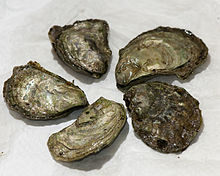This article has an unclear citation style. (March 2012) |
| Olympia oyster | |
|---|---|

| |
| Scientific classification | |
| Domain: | Eukaryota |
| Kingdom: | Animalia |
| Phylum: | Mollusca |
| Class: | Bivalvia |
| Order: | Ostreida |
| Family: | Ostreidae |
| Genus: | Ostrea |
| Species: | O. lurida
|
| Binomial name | |
| Ostrea lurida (Carpenter, 1864)
| |

Ostrea lurida, common name the Olympia oyster, after Olympia, Washington in the Puget Sound area, is a species of small, edible oyster, a marine bivalve mollusk in the family Ostreidae. This species occurs on the northern Pacific coast of North America. Over the years the role of this edible species of oyster has been partly displaced by the cultivation of non-native edible oyster species.
Ostrea lurida is now known to be separate from a similar-appearing species, Ostrea conchaphila, which occurs further south, south of Baja California, in Mexico. Molecular evidence has recently confirmed the separate status of the two species.[1] However, previously, for a period of time, Ostrea lurida was considered to be merely a junior synonym of Ostrea conchaphila.
O. lurida has been found in archaeological excavations along the Central California coast of the Pacific Ocean, demonstrating that it was a marine species exploited by the Native American Chumash people.[2] Large shell mounds, also known as middens, have been found during excavations consisting of discarded oyster shells estimated to be at least 3000 years in age.[3]
- ^ Polson, Maria P.; Hewson, William E.; Eernisse, Douglas J.; Baker, Patrick K.; Zacherl, Danielle C. (2009-11-21). "You Say Conchaphila, I Say Lurida: Molecular Evidence for Restricting the Olympia Oyster (Ostrea lurida Carpenter 1864) to Temperate Western North America". Journal of Shellfish Research. 28 (1): 11–21. doi:10.2983/035.028.0102. ISSN 0730-8000. S2CID 23557487.
- ^ C.M. Hogan, 2008
- ^ Gordon, Blanton, Nosho, David, Nancy, Terry (2001). Heaven on the Half Shell. Seattle, WA: Washington Sea Grant Program. p. 34. ISBN 978-1558685505.
{{cite book}}: CS1 maint: multiple names: authors list (link)